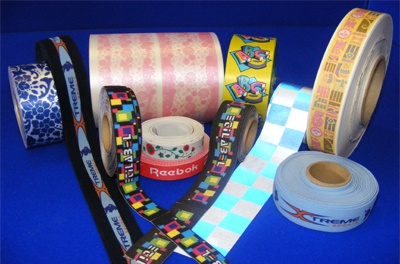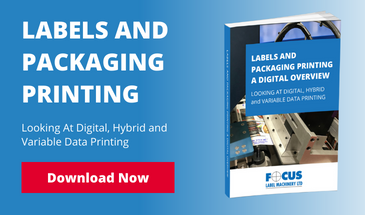
Printing on ribbon involves either one or two-sided printing. For wash care labels, this usually depends on how much information needs to be printed on the label . When considering the best method for printing your labels, a combination of understanding the available printing processes and expert information from a printing professional can go a long way to helping you make an informed choice.
The Flexographic Printing Process
Flexographic printing is a high-speed process which can be used for printing on several types of materials. There are three types of flexographic printing: central impression, in-line and stacked. Where the printing of textile ribbon is concerned, the central impression drum press is used in order to maintain good tension control and print registration.
For care labels, this type of press uses water-based or solvent-based inks that dry via absorption and evaporation. The ribbon is fed into the press, where it is then pulled through the machine. Around the central impression drum itself, there is a series of print stations, each printing a single colour.
The intensity of colour transferred to the ribbon depends on how the inks are deposited onto the textile ribbon. The anilox roll is responsible for the volume of ink transfer. The ceramic-coated surface of the anilox roll is engraved with thousands of small cells which hold ink. The cells can be engraved to varying depths, diameters and profiles, in order to deposit the required volume of ink, and give the desired colour strength.
How Ink is Transferred onto Ribbon using thermal transfer method
Just as important as the machine used for printing on ribbon is the way in which ink is transferred onto the ribbon. Thermal transfer is possible in two ways: dye sublimation or thermal printing.
The Dye Sublimation Method
Dye sublimation printing is a process that transfers dye from a carrier substrate onto polyester or polymer-coated ribbon using heat and pressure. These are applied to both the dye and the ribbon, transforming liquid dyes into gas, and opening the pores in the ribbon’s fabric. The gaseous dye enters the ribbon’s pores, essentially becoming part of the ribbon fabric. Once cooled, the pores close to trap the dye, making it permanent.
Typically, a multi-colour design would be printed onto the carrier substrate, which is the used in a secondary process, where the image is transferred to the polyester ribbon, whilst passing around a heated drum.
Another common dye sublimation process sees one colour being applied at a time. Print rollers move the ribbon and a colour panel together under the machine’s thermal printing head. The thermal printing head is capable of rapid temperature changes, and can also transfer dye in varying amounts. Once one colour has finished printing, the ribbon is wound by the machine onto the next colour panel, and the process begins again until all desired colours have been printed.
Thermal Printing
The thermal printing process also uses heat, albeit in a different way. The thermal process uses a ribbon that transfers its colour onto fabric following the application of heat, which melts the ink. Each colour has its own ribbon, and the resulting quality of the labels is very durable. Images and text are also unmistakeably clear using the thermal printing method.
The ribbons used to transfer ink via thermal printing can be made of wax, wax resin or full resin. Each type will produce a different quality and durability to the label. In order to ensure that the right ribbon is used for the substrate being printed, it must be correctly matched to the ribbon fabric.
Thermal printing is a popular method of printing labels onto textile ribbon because there is no waiting for the ink to dry, the print is long-lasting and it can easily handle temperature changes.
However, the process is slow and very wasteful, since the spent transfer ribbon cannot be re-used, even though only a relatively small amount of the wax or resin is actually used.
Get Expert Assistance with your Label Printing
We know that you may still have questions about the best machine for printing your textile ribbons. That’s why our team has written an eBook called “Label Printing for Textiles”. “Label Printing for Textiles” will educate you on available ribbon printing machinery, and how choosing the right tools can help you improve your business’s profitability and productivity. Best of all, you can get this eBook absolutely free; just click here to download.







